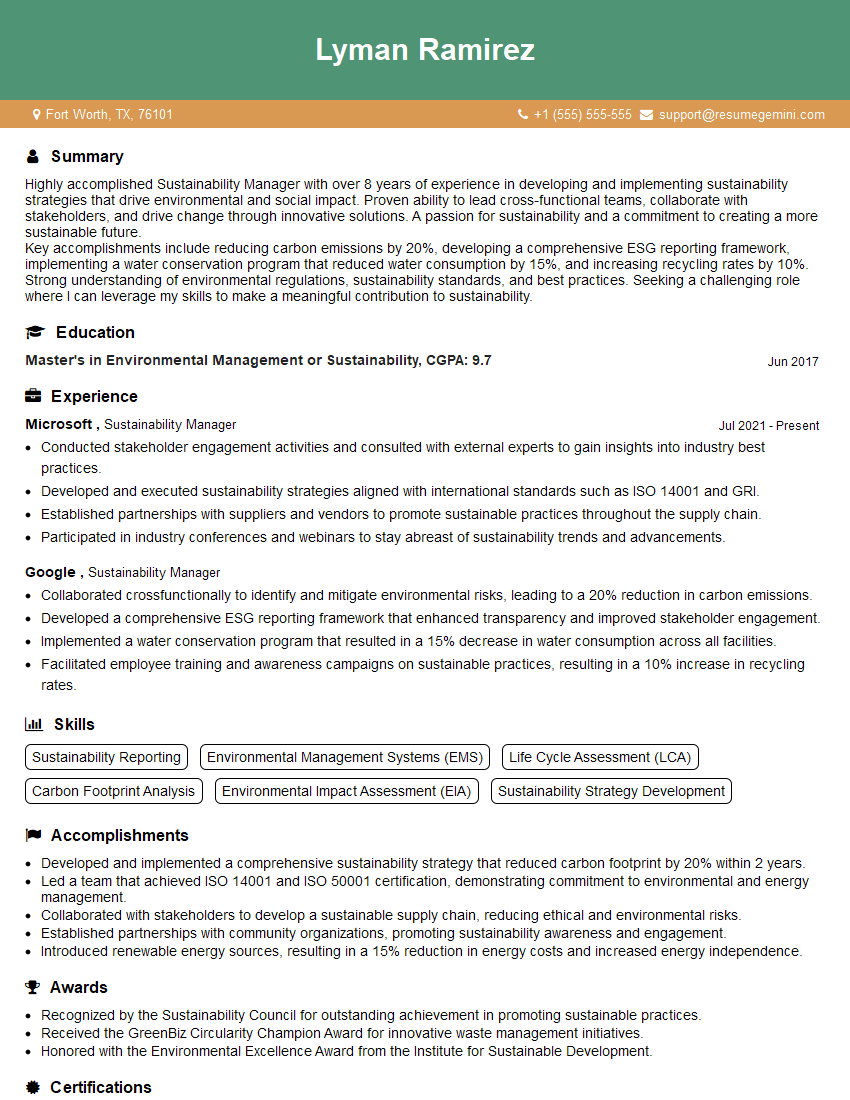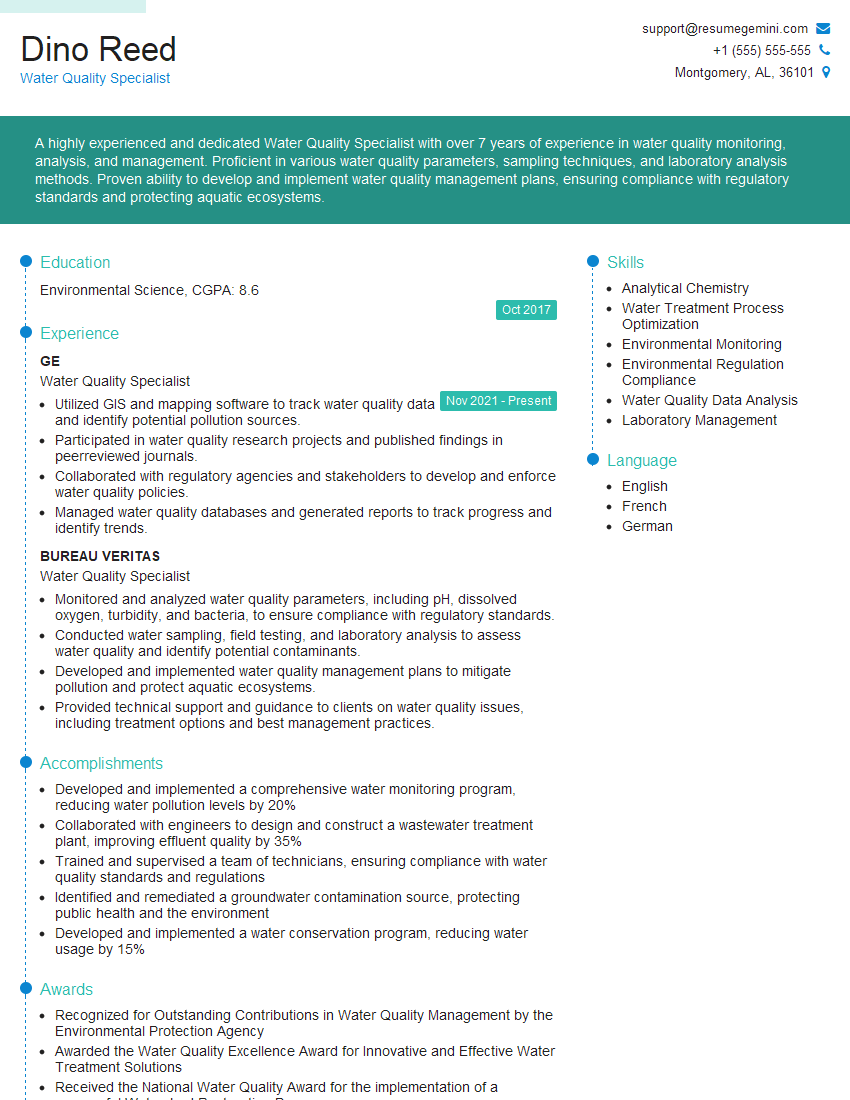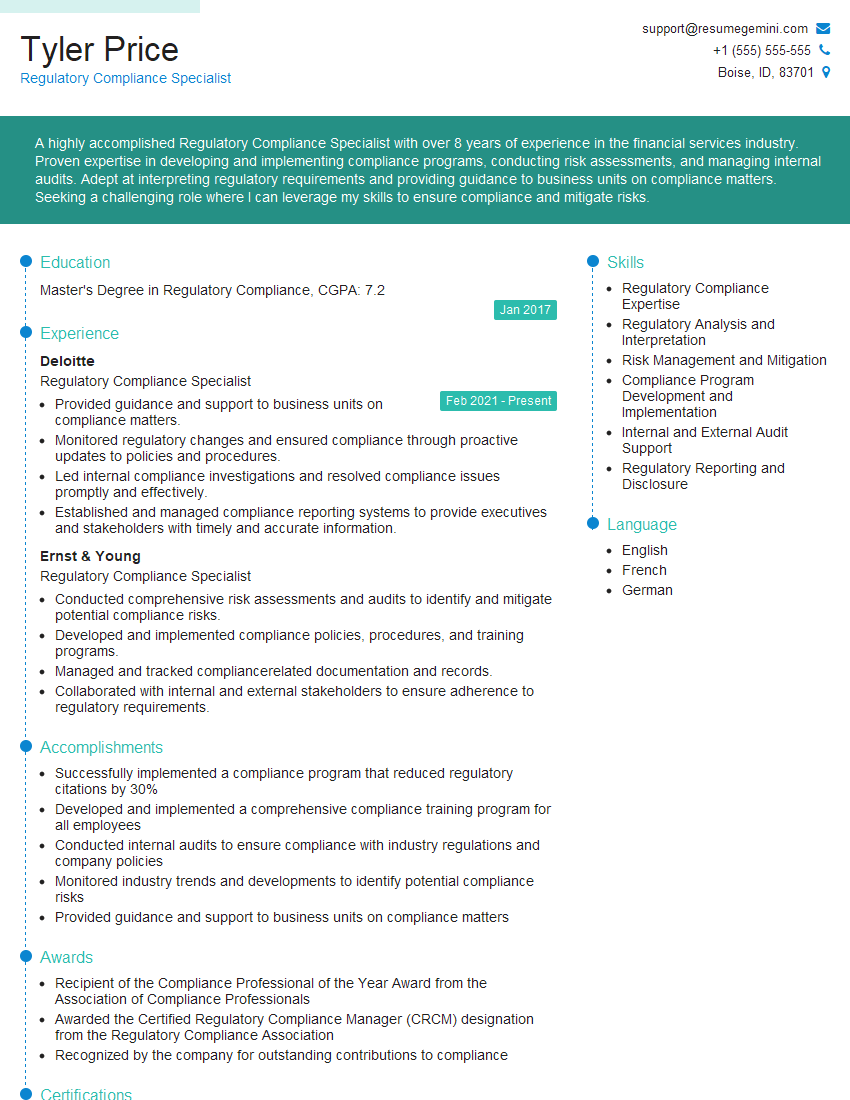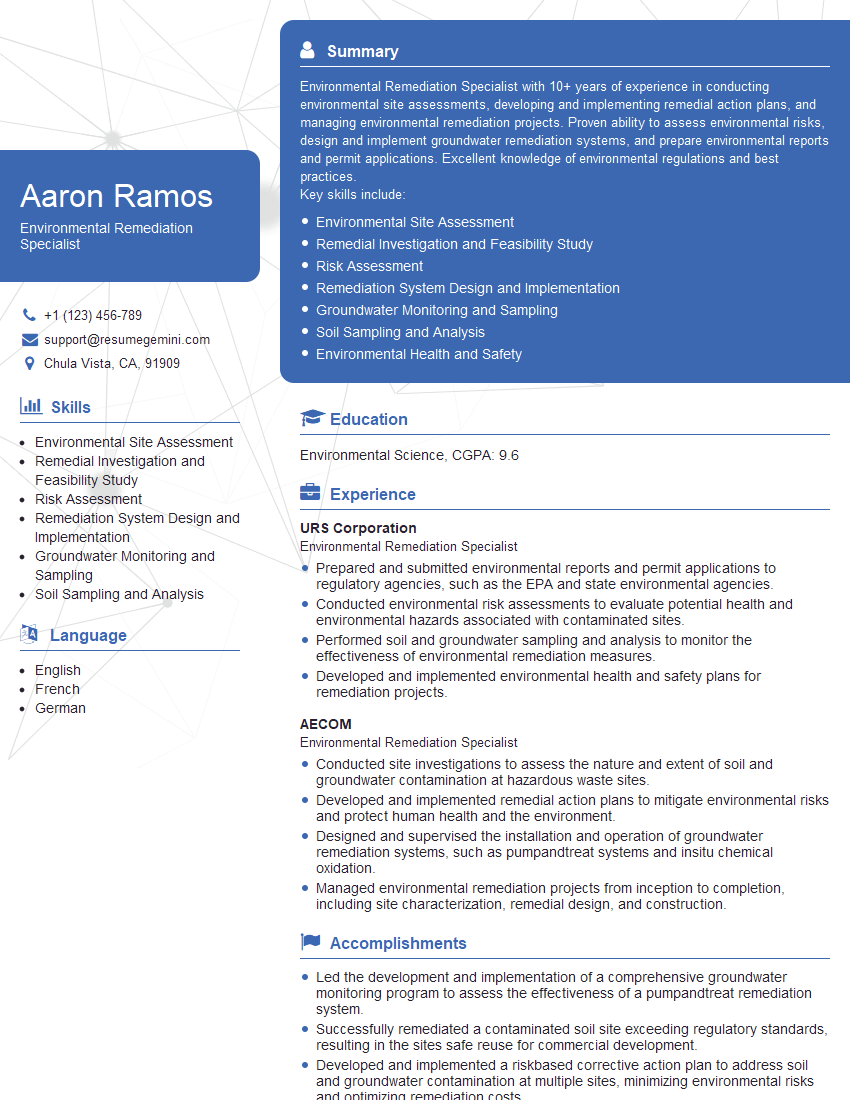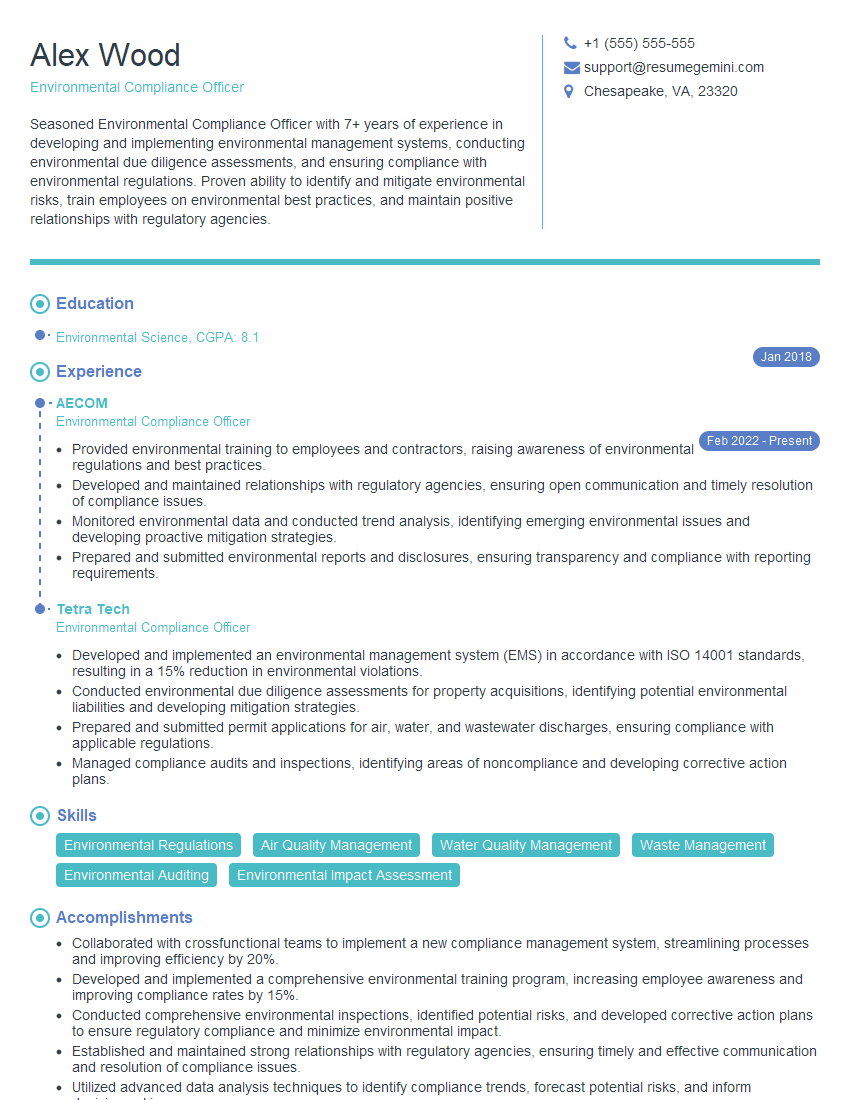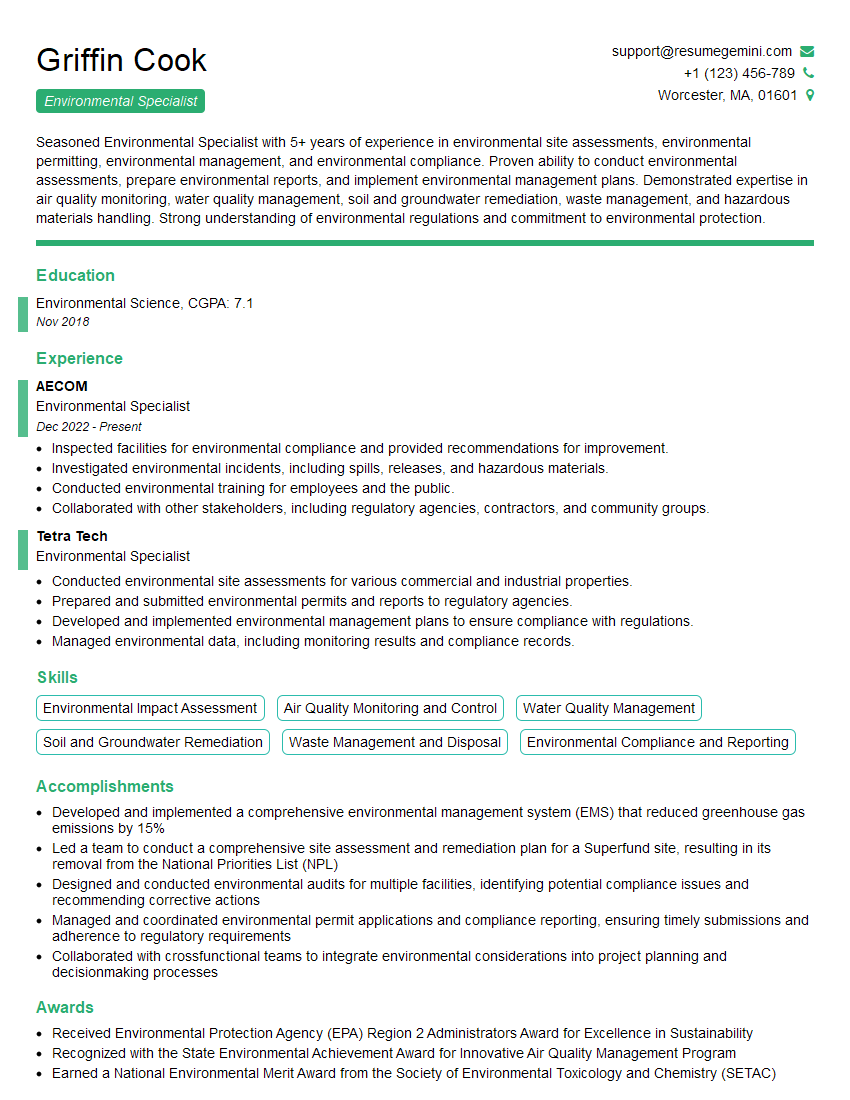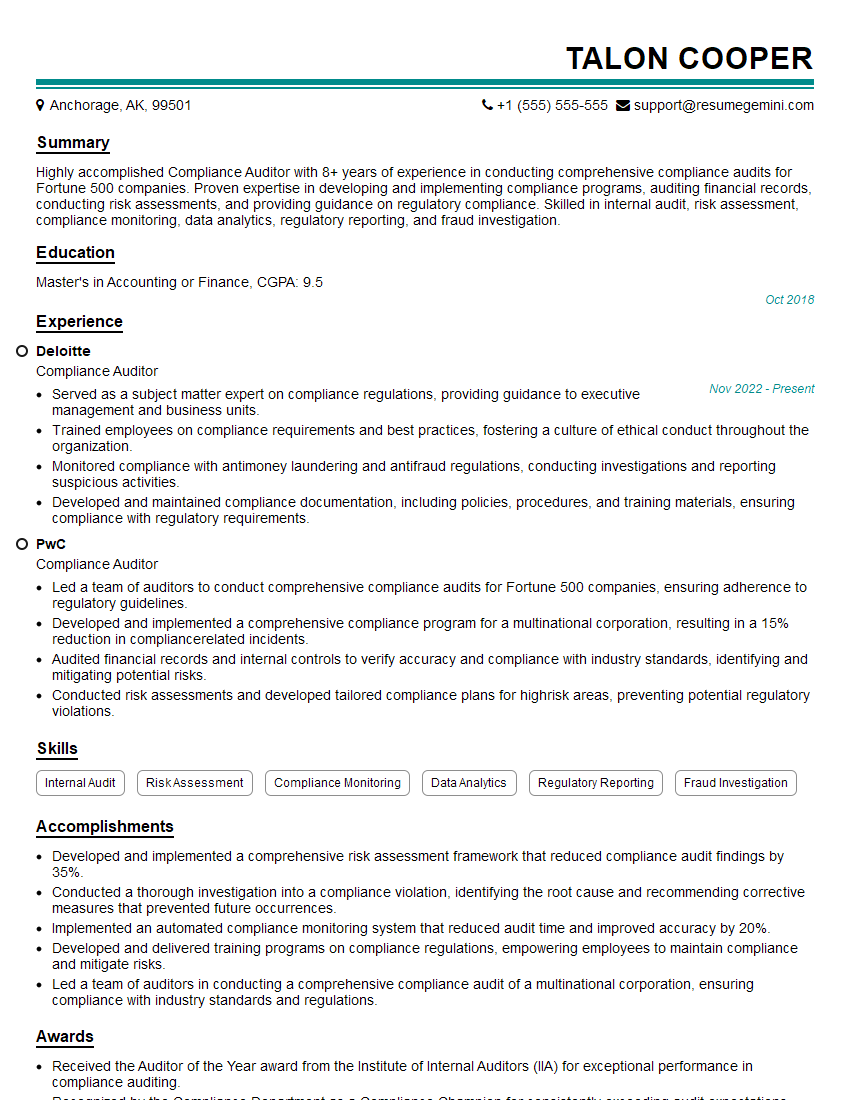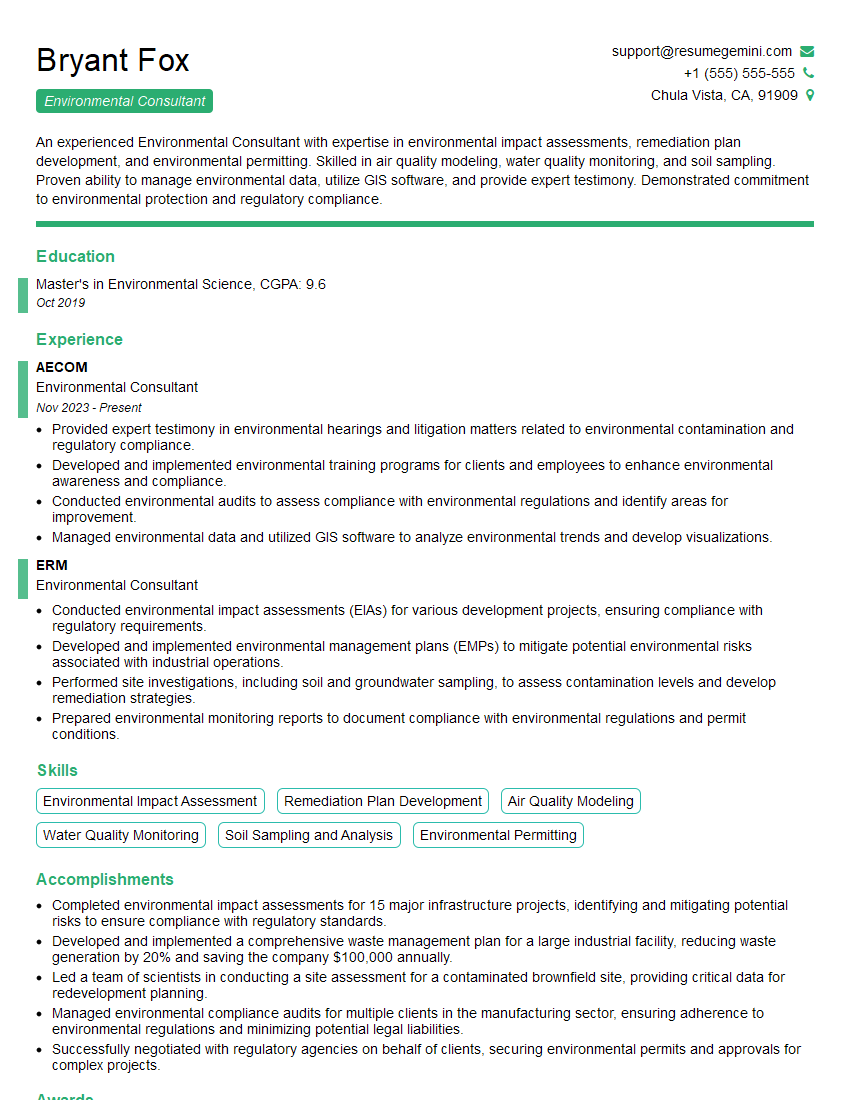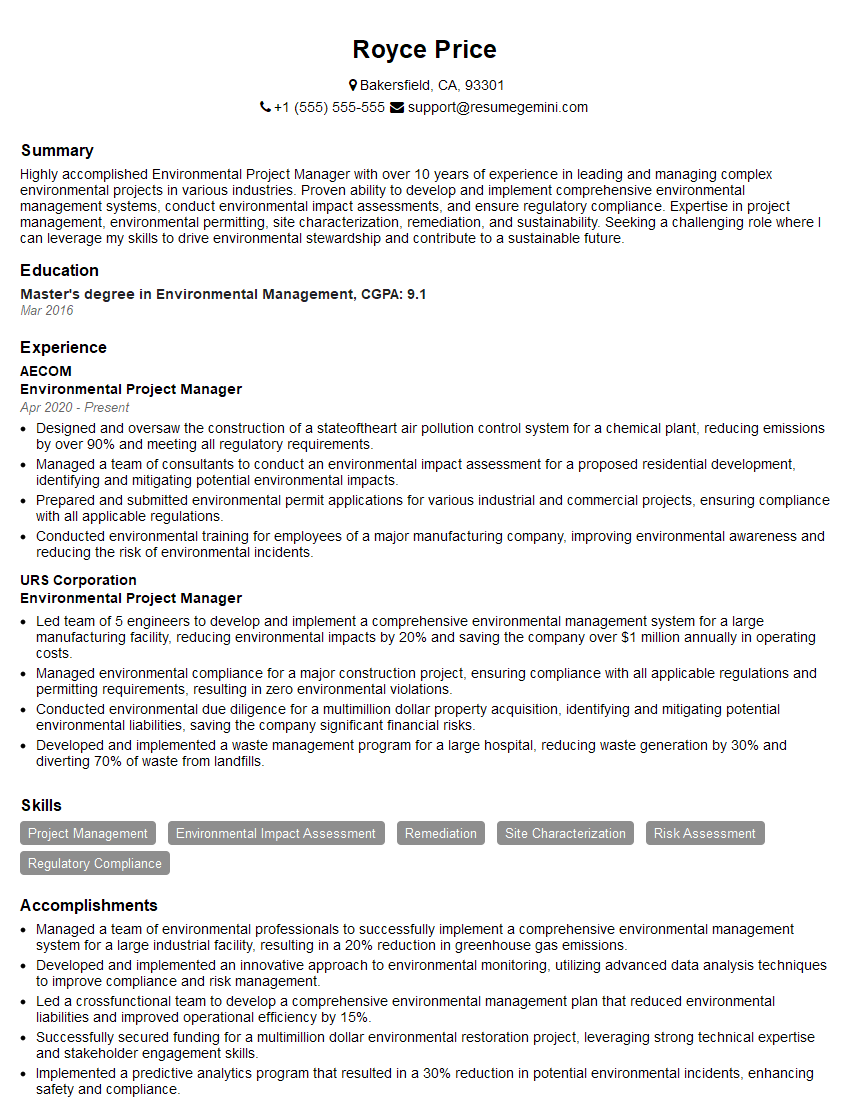The right preparation can turn an interview into an opportunity to showcase your expertise. This guide to Environmental Audit and Inspection interview questions is your ultimate resource, providing key insights and tips to help you ace your responses and stand out as a top candidate.
Questions Asked in Environmental Audit and Inspection Interview
Q 1. Describe your experience conducting environmental audits according to ISO 14001.
My experience conducting ISO 14001 environmental audits spans over ten years, encompassing a wide range of industries, from manufacturing to healthcare. I’ve led numerous audits, both internal and external, meticulously following the standard’s requirements. This includes a thorough review of the organization’s Environmental Management System (EMS), assessing its effectiveness in meeting stated environmental objectives and legal compliance. A typical audit involves a detailed document review, site inspections, interviews with personnel at various levels, and analysis of environmental performance data. For example, in one audit of a manufacturing plant, we identified a significant gap in their waste management system, leading to recommendations for improved waste segregation, recycling programs, and employee training. The outcome was a documented improvement plan, leading to reduced waste generation and associated costs.
The process typically involves planning the audit scope, conducting the audit itself, reporting findings, and following up on corrective actions. I use a structured approach ensuring that all aspects of the ISO 14001 standard are covered, and reports are clear, concise, and actionable. The reports always include recommendations for improvement.
Q 2. Explain the process of identifying and assessing environmental risks.
Identifying and assessing environmental risks involves a systematic approach. First, we identify potential environmental impacts associated with an organization’s operations, products, or services. This is done through brainstorming sessions, hazard identification checklists, and analysis of historical data (e.g., accident reports, near misses). For example, a manufacturing plant might identify risks associated with air emissions, wastewater discharge, and hazardous waste generation. Next, we assess the likelihood and severity of each identified risk. Likelihood refers to the probability of the risk occurring, while severity refers to the potential environmental consequences (e.g., pollution of a water source, biodiversity loss). This is often achieved through risk matrices, assigning numerical values to likelihood and severity, and creating a risk level score. Then, we prioritize risks based on their overall level (high, medium, low). Finally, we develop and implement risk mitigation strategies, such as implementing improved control measures, implementing emergency response plans, or implementing environmental monitoring programs. These strategies are then reviewed and updated on a regular basis. This entire process often includes a review of relevant environmental regulations to determine the potential legal consequences of each identified risk.
Q 3. How do you determine the compliance of an organization with environmental regulations?
Determining compliance with environmental regulations requires a thorough understanding of both the organization’s operations and the applicable laws and regulations. This process begins with identifying all relevant regulations, such as air permits, water discharge permits, waste management regulations and others. We then compare the organization’s environmental performance data (e.g., emissions data, waste generation data, water usage data) against the regulatory limits and requirements. For example, we might compare a factory’s air emissions to the permitted levels specified in their air permit, or its wastewater discharges to the limits set by the relevant water quality regulations. Discrepancies indicate non-compliance and necessitate further investigation and corrective action. We also review the organization’s compliance documentation, such as permits, records of monitoring, and reporting data. This process is crucial to ensuring legal compliance and mitigating potential legal penalties and reputational damage. Regular compliance monitoring is essential and must be coupled with training of employees on environmental compliance and responsibilities.
Q 4. What are the key elements of an effective environmental management system (EMS)?
A robust Environmental Management System (EMS) comprises several key elements, all interconnected to ensure effective environmental performance. Firstly, it needs a strong leadership commitment and a clearly defined environmental policy. The policy must state the organization’s commitment to environmental protection and sustainable practices, and this needs to be communicated across all levels of the organization. This is followed by a comprehensive environmental aspect register, which identifies all environmental aspects of operations, and an associated impact assessment. The EMS must incorporate environmental objectives and targets, which are specific, measurable, achievable, relevant, and time-bound (SMART). It also needs a systematic approach to planning and implementing environmental programs, including monitoring and evaluation of their effectiveness. Regular internal audits and management reviews are also crucial, as they evaluate the EMS’s effectiveness and identify areas for improvement. Continual improvement is a central pillar, emphasizing the need for regular updates to the EMS based on audit findings, performance data, and changes in environmental regulations. Finally, employee training and communication are essential components for successful EMS implementation. Proper record keeping ensures traceability and accountability.
Q 5. Describe your experience with environmental impact assessments (EIAs).
My experience with Environmental Impact Assessments (EIAs) involves leading and participating in multidisciplinary teams to assess the potential environmental effects of proposed projects, such as new infrastructure developments, industrial facilities, or large-scale mining operations. The process typically begins with scoping studies to define the project’s potential environmental impacts and the geographical area to be studied. We then collect baseline data through field surveys, environmental monitoring, and literature reviews. Potential impacts are identified and evaluated using appropriate methodologies. For example, we use modeling software to predict the impact of a new highway on air quality, or species impact assessments to assess the impacts of a proposed dam on aquatic life. Mitigation measures to minimize negative environmental impacts are developed and integrated into the project design. The findings are then documented in a comprehensive EIA report which forms a crucial element of the project’s environmental approvals process. Public consultation is often a key part of the process to ensure transparency and accountability.
Q 6. How do you interpret and apply environmental regulations?
Interpreting and applying environmental regulations requires a deep understanding of the legal framework and its implications for organizations. This involves reviewing the specific legislation or regulations, considering any associated guidance or interpretations provided by environmental agencies. For example, I need to understand the specific emission limits or wastewater discharge requirements within a permit, including monitoring and reporting frequencies. I also stay updated on changes in legislation and case law to maintain accurate interpretations. This necessitates regular review of legal updates and engagement with relevant regulatory authorities. I use a systematic approach to ensure all relevant regulations are identified, and their requirements are translated into practical actions for the organization. I also must understand the penalties for non-compliance and their implications, allowing me to prioritize areas requiring improvement.
Q 7. Explain your experience with different types of environmental audits (e.g., internal, external, first-party, second-party, third-party).
My experience encompasses various types of environmental audits. Internal audits are conducted by an organization’s own personnel to assess the effectiveness of their EMS. External audits are conducted by independent auditors, like myself, to provide an objective evaluation of the organization’s compliance and EMS effectiveness. First-party audits are conducted by an organization to assess its own compliance, second-party audits are performed by one organization on another (e.g., a client auditing a supplier), and third-party audits are done by an independent certification body leading to certification (e.g. ISO 14001 certification). Each type requires different approaches and levels of scrutiny. For example, while an internal audit might focus on identifying areas for improvement, an external or third-party audit will be more focused on ensuring compliance with regulations and the relevant standards. The scope and depth of each audit vary considerably, depending on the objectives and the type of audit being conducted. I adapt my approach and methodology to the specific context of each audit.
Q 8. How do you document and report your audit findings?
Documenting and reporting audit findings is crucial for demonstrating compliance and driving improvements. My approach involves a structured process, beginning with detailed checklists and on-site observations recorded during the audit. I use a standardized format for recording each finding, including a unique identifier, a description of the non-conformity, its location, severity, and any supporting evidence (e.g., photographs, data logs). This information is compiled into a comprehensive report, organized logically by area or topic. The report clearly states the audit’s scope, methodology, and the overall conclusions. It’s structured with an executive summary providing a high-level overview, followed by detailed findings, including recommendations for corrective action. I always ensure the report is clear, concise, and avoids technical jargon where possible. For example, instead of using complex statistical analysis solely, I use charts and graphs to visually represent key findings, making them more accessible to non-technical stakeholders. Finally, I always include a timeline for addressing non-conformances and a section outlining the verification process to ensure effective implementation of corrective actions.
- Standardized Format: A consistent template ensures all findings are documented consistently.
- Supporting Evidence: Photos and data strengthen the report’s credibility.
- Clear and Concise Language: Avoids misinterpretation.
- Visual Representation: Charts and graphs enhance understanding.
- Actionable Recommendations: Clearly outlines next steps and responsibilities.
Q 9. Describe your experience using environmental audit software or tools.
I have extensive experience using various environmental audit software and tools. My preferred software suite includes [Software Name 1] and [Software Name 2], which allow for streamlined data collection, analysis, and report generation. [Software Name 1], for instance, facilitates on-site data entry using mobile devices, capturing real-time observations and supporting evidence. This streamlines the audit process and eliminates manual data entry. [Software Name 2] excels in data analysis and reporting, allowing for the creation of customized reports with interactive dashboards that visualize key performance indicators. I’m also proficient in using GIS (Geographic Information Systems) software to map environmental impacts and assets, aiding in identifying areas of potential environmental risk. For example, during an audit of a large manufacturing plant, I used [Software Name 2] to analyze emissions data, identifying seasonal variations and areas needing optimization. The resulting visualizations helped communicate these findings clearly to management and facilitated the development of targeted corrective actions.
Q 10. How do you handle non-conformances identified during an environmental audit?
Handling non-conformances requires a systematic approach. First, I verify the accuracy of the identified non-conformances through further investigation and data analysis. Each non-conformance is then categorized based on its severity and potential environmental impact. This classification helps prioritize corrective actions. The next step involves documenting each non-conformance in detail, including its root cause and potential consequences if left unaddressed. I then collaborate with the audited entity to develop and implement corrective actions that mitigate the identified risks. Throughout the entire process, the focus is on collaboration and problem-solving rather than simply pointing out flaws. This collaborative approach often involves brainstorming sessions with the organization’s environmental management team to jointly develop effective and sustainable solutions. For example, if a non-compliance involves improper waste disposal, I would work with the organization to create a revised waste management plan, including training for staff and the implementation of improved waste segregation procedures. The effectiveness of the corrective actions is then verified during follow-up audits.
Q 11. Explain your experience with corrective and preventive actions (CAPA).
Corrective and Preventive Actions (CAPA) are central to environmental audit effectiveness. My experience with CAPA involves a structured process, beginning with a thorough root cause analysis. I use various tools like the ‘5 Whys’ technique or fishbone diagrams to identify the underlying causes of non-conformances. Once the root causes are identified, I work collaboratively with the audited entity to develop and implement specific, measurable, achievable, relevant, and time-bound (SMART) corrective actions to address immediate issues. Preventive actions are designed to prevent similar non-conformances from recurring. These might include process improvements, staff training, or changes in equipment or materials. The entire CAPA process is documented, and effectiveness is verified through follow-up audits or periodic reviews. I regularly track the progress of CAPA implementation and adjust plans as needed. For example, during an audit of a construction site, I identified a non-compliance related to soil erosion. The CAPA involved implementing improved erosion control measures and providing training to the site crew on proper best management practices. This included implementing sediment basins, reinforcing ditch lines, and regular inspection of implemented measures.
Q 12. How do you ensure the objectivity and impartiality of your audits?
Maintaining objectivity and impartiality is paramount. This starts with adhering to a strict code of ethics and professional standards. I ensure that all audits are conducted according to pre-defined procedures and checklists, preventing bias. I maintain a professional distance from the audited entity, avoiding any conflicts of interest or relationships that could compromise my objectivity. Transparency in my methodology and reporting process is vital. I make sure that all findings are supported by verifiable evidence and I clearly articulate any limitations of my audit. Regular professional development ensures I stay current with best practices and avoid any outdated or biased methodologies. For example, I may utilize peer review for complex issues to ensure my conclusions are thorough and well-reasoned.
Q 13. What are the key performance indicators (KPIs) used to measure environmental performance?
Key Performance Indicators (KPIs) for environmental performance vary depending on the context of the audit. However, some common KPIs include:
- Greenhouse gas emissions (GHG): Measured in tons of CO2 equivalent, this KPI tracks the organization’s carbon footprint.
- Energy consumption: Measured in kilowatt-hours (kWh) or gigajoules (GJ), this KPI reflects energy efficiency.
- Waste generation: Measured in tons or kilograms, this KPI assesses waste management effectiveness.
- Water consumption: Measured in cubic meters or gallons, this KPI indicates water usage efficiency.
- Compliance rate: Percentage of environmental regulations met.
- Accident/incident rate: Number of environmental incidents per unit of production.
- Resource efficiency: Ratio of output to input resources.
The selection of relevant KPIs depends on the organization’s specific activities and environmental challenges. For example, a manufacturing plant might focus on GHG emissions and resource efficiency, while a water utility might prioritize water consumption and leakage rates.
Q 14. How do you communicate audit findings to management and stakeholders?
Communicating audit findings effectively is critical. My approach involves tailoring the communication style to the audience. For management, I typically provide a concise executive summary highlighting key findings and recommendations, followed by a more detailed report. For stakeholders, I might use simpler language and visual aids, such as infographics or presentations. The communication channel also varies; for example, I might use formal reports for management, presentations for wider stakeholder groups, and informal meetings to address specific issues. I always ensure that my communication is timely, clear, and facilitates open dialogue. Follow-up meetings are crucial to ensure that recommendations are understood and implemented effectively. For example, following an environmental audit of a hotel, I presented the findings in a presentation to the management team and then provided a detailed report to the environmental manager to support the subsequent corrective actions. I also addressed concerns and clarified ambiguities from both parties during follow-up sessions. This allowed for a thorough understanding of the issues and a commitment to collaborative action.
Q 15. Describe your experience with environmental monitoring and sampling.
Environmental monitoring and sampling is the cornerstone of any effective environmental audit. It involves systematically collecting data on environmental parameters to assess the condition of air, water, soil, and other media. My experience encompasses a wide range of sampling techniques, from grab sampling of water bodies to using specialized equipment for air quality monitoring, such as high-volume samplers and continuous monitoring instruments. I’m proficient in selecting appropriate sampling locations based on risk assessment and statistical design principles. For example, in a recent project assessing a manufacturing facility’s impact on groundwater, we employed a stratified random sampling strategy to ensure representative data collection across the potential impacted area. This included drilling boreholes to various depths and analyzing samples for a suite of contaminants. Data analysis, including statistical testing for significance and trend analysis, is an integral part of my process, ultimately leading to accurate and defensible conclusions about environmental impacts.
I’ve worked with various laboratory methods to analyze samples, ensuring chain-of-custody protocols are strictly followed. I’m familiar with laboratory accreditation standards and ensuring the quality of the data obtained. Accurate and reliable data are critical for effective decision-making and compliance reporting.
Career Expert Tips:
- Ace those interviews! Prepare effectively by reviewing the Top 50 Most Common Interview Questions on ResumeGemini.
- Navigate your job search with confidence! Explore a wide range of Career Tips on ResumeGemini. Learn about common challenges and recommendations to overcome them.
- Craft the perfect resume! Master the Art of Resume Writing with ResumeGemini’s guide. Showcase your unique qualifications and achievements effectively.
- Don’t miss out on holiday savings! Build your dream resume with ResumeGemini’s ATS optimized templates.
Q 16. Explain your understanding of environmental legislation and regulations (mention specific examples).
A deep understanding of environmental legislation and regulations is crucial for conducting effective environmental audits and inspections. My knowledge spans various national and international regulations, such as the Clean Air Act (CAA), the Clean Water Act (CWA), and the Resource Conservation and Recovery Act (RCRA) in the US, as well as the EU’s REACH regulation and the Basel Convention on the Control of Transboundary Movements of Hazardous Wastes and their Disposal.
The Clean Air Act, for instance, sets standards for air pollutants and requires facilities to obtain permits and monitor emissions. I’ve directly applied this knowledge in numerous audits where we’ve reviewed permit applications and compliance reports, ensuring facilities are adhering to established emission limits. Similarly, the Clean Water Act regulates water quality and discharges. My experience includes conducting wastewater discharge monitoring reports, sampling, and analysis to ensure compliance. The Resource Conservation and Recovery Act (RCRA) governs hazardous waste management; I frequently audit waste management practices at industrial facilities, ensuring proper storage, treatment, and disposal of hazardous waste, and verifying compliance with RCRA regulations. Understanding these regulations allows me to identify potential non-compliance issues and recommend corrective actions.
Q 17. How do you stay up-to-date with changes in environmental regulations and best practices?
Staying current with environmental regulations and best practices is a dynamic and ongoing process. I actively engage in several strategies to maintain my expertise. This includes subscribing to professional journals such as Environmental Science & Technology and Journal of Environmental Quality, attending industry conferences and workshops hosted by organizations such as the Environmental Protection Agency (EPA) and the Society of Environmental Toxicology and Chemistry (SETAC), and participating in professional development courses. Online resources such as the EPA’s website and the websites of relevant governmental agencies are invaluable for staying informed about updates to regulations. Networking with other environmental professionals through professional organizations also provides valuable insights and discussions about emerging trends and best practices.
Furthermore, I regularly review relevant case law and legal updates to understand how regulations are being interpreted and applied in practice. This ensures that my audit approach remains current and legally sound.
Q 18. Describe your experience with different types of environmental media (air, water, soil).
My experience with environmental media (air, water, soil) is extensive and spans various project types. In air quality assessments, I’ve utilized various techniques, including stack testing for emissions monitoring and ambient air monitoring to assess air quality around industrial facilities. This involves understanding meteorological factors that can impact pollutant dispersion. In water quality assessments, I have experience with sampling surface water, groundwater, and wastewater, analyzing parameters such as pH, dissolved oxygen, turbidity, and various chemical constituents. For example, in one project, we assessed the impact of agricultural runoff on a nearby river, analyzing water samples for nutrient levels (nitrogen and phosphorus) and pesticides. In soil assessments, my work has included conducting soil sampling and laboratory analyses to identify contaminants such as heavy metals, petroleum hydrocarbons, and pesticides. This often involves site characterization and risk assessment work, in which we determine the extent of contamination and the potential risk to human health and the environment.
Q 19. What is your experience with environmental due diligence?
Environmental due diligence is a critical process for identifying and assessing potential environmental liabilities associated with a property or business transaction. My experience in this area includes conducting Phase I, Phase II, and sometimes Phase III environmental site assessments. A Phase I Environmental Site Assessment involves reviewing historical records and conducting a site reconnaissance to identify potential environmental concerns. A Phase II involves sampling and testing to confirm the presence and extent of contamination. A Phase III might involve remediation activities. I’ve helped clients make informed decisions regarding potential risks and liabilities associated with acquiring or selling a property, or during mergers and acquisitions. For example, I conducted a due diligence assessment for a client considering purchasing an industrial site, identifying past spills of chlorinated solvents and subsequently providing a cost estimate for remediation. This allowed the client to negotiate a fair purchase price, factoring in the environmental liabilities.
Q 20. How do you manage environmental audit projects?
Managing environmental audit projects requires a structured and methodical approach. I typically follow a project management framework that includes defining the project scope, developing a detailed work plan, assembling a qualified team, coordinating fieldwork, managing data analysis and reporting, and communicating effectively with clients. I always begin by clearly defining the project’s objectives, including specific environmental regulations and standards to be addressed. This is crucial for ensuring the audit aligns with the client’s needs and applicable regulations. A detailed work plan outlines all tasks, timelines, and responsibilities. I use project management software to track progress, manage resources, and meet deadlines. Effective communication is key, involving regular updates with the client, to keep them informed about progress, any challenges encountered, and the findings. Finally, a comprehensive report detailing findings, conclusions, and recommendations is delivered to the client.
Q 21. What is your experience with waste management audits?
Waste management audits are a significant part of my practice, focusing on evaluating a facility’s waste generation, storage, handling, treatment, and disposal practices. This involves reviewing waste manifests, inspecting waste storage areas, verifying compliance with applicable regulations (like RCRA in the US, or equivalent regulations in other jurisdictions), and identifying opportunities for waste reduction and recycling. For instance, a recent audit of a manufacturing facility revealed significant opportunities to improve their waste segregation practices, leading to a decrease in hazardous waste generation and a cost savings through increased recycling. I work closely with clients to implement recommendations, helping them to develop comprehensive waste management plans that minimize environmental impact and ensure regulatory compliance. This often involves training employees on proper waste handling procedures and implementing robust record-keeping systems.
Q 22. How do you ensure the accuracy and reliability of your audit data?
Ensuring the accuracy and reliability of audit data is paramount in environmental auditing. It’s akin to building a house on a solid foundation – if the data is flawed, the entire audit’s conclusions are compromised. We achieve this through a multi-pronged approach:
- Rigorous Data Collection Methods: We employ standardized methodologies and checklists, ensuring consistency across all audits. This includes using calibrated equipment, employing multiple data points where feasible, and documenting all procedures meticulously. For example, when measuring air emissions, we use EPA-approved methods and cross-reference readings with multiple devices.
- Data Verification and Validation: We don’t just collect data; we meticulously check it. This involves comparing data against historical records, reviewing for outliers, and employing statistical analysis to identify any anomalies. If discrepancies exist, we investigate their root causes before incorporating the data into our report.
- Chain of Custody: Maintaining a complete chain of custody for samples is crucial, especially for environmental samples like soil or water. This prevents tampering and ensures the integrity of the samples from collection to analysis. Each step in the process is documented, with signatures and timestamps.
- Qualified Personnel: Our team consists of highly trained and experienced auditors, certified in relevant fields (e.g., Certified Environmental Auditor). Their expertise ensures accurate data interpretation and the application of appropriate regulations.
- Quality Assurance/Quality Control (QA/QC): We implement robust QA/QC protocols throughout the entire audit process. This involves regular internal audits of our procedures and external audits by accredited bodies to ensure compliance with recognized standards like ISO 14001.
By implementing these measures, we ensure the data we present is reliable, defensible, and supports credible conclusions.
Q 23. Describe a situation where you had to resolve a conflict during an environmental audit.
During an audit of a manufacturing facility, we discovered that the company was discharging wastewater exceeding permitted limits. The plant manager, while acknowledging the issue, vehemently denied the severity, claiming our equipment was faulty and our sampling methods were incorrect. This created a significant conflict. To resolve it, I:
- Maintained Professionalism: I remained calm and respectful, emphasizing our commitment to objective fact-finding.
- Presented Clear Evidence: I presented our data, including detailed sampling logs, equipment calibration records, and laboratory analysis reports, all meticulously documented, leaving no room for ambiguity.
- Invited Independent Verification: I suggested involving an independent third-party laboratory to re-analyze the samples, offering transparency and eliminating any perception of bias. The results confirmed our findings.
- Focused on Solutions: Instead of dwelling on blame, I collaborated with the plant manager to explore remediation strategies. We identified the source of the excess discharge and collaboratively developed a corrective action plan.
This situation highlighted the importance of clear communication, evidence-based argumentation, and a collaborative approach to conflict resolution in environmental audits. Transparency and a focus on solutions, rather than confrontation, are key to successful conflict management.
Q 24. How do you prioritize audit findings based on risk and impact?
Prioritizing audit findings based on risk and impact is a crucial step in environmental auditing. It’s about focusing resources where they’ll have the most significant positive impact. We utilize a risk-based approach, often employing a matrix that considers:
- Likelihood of Occurrence: How likely is it that the non-compliance will occur or cause harm?
- Severity of Impact: What are the potential environmental, social, and economic consequences if the non-compliance occurs? This may include fines, reputational damage, or ecological harm.
Findings are categorized into high, medium, and low priority based on the combination of likelihood and severity. For example:
- High Priority: A significant release of hazardous materials with high likelihood of occurrence and severe environmental and health consequences.
- Medium Priority: Minor exceedances of permit limits with moderate likelihood and limited environmental impact.
- Low Priority: Minor administrative non-compliance with low likelihood of significant impact.
This prioritization ensures that we focus our resources on addressing the most critical issues first, maximizing the effectiveness of our audit and remediation efforts. It’s a strategic approach to environmental management, ensuring we effectively allocate our time and resources.
Q 25. What is your understanding of life cycle assessment (LCA)?
Life Cycle Assessment (LCA) is a comprehensive method for evaluating the environmental impacts associated with all stages of a product’s life, from raw material extraction to disposal or recycling. It’s a holistic approach that goes beyond just looking at a single stage of a product’s life, providing a cradle-to-grave analysis. The four key stages of LCA are:
- Goal and Scope Definition: Defining the purpose of the LCA and specifying the product system boundaries.
- Inventory Analysis: Quantifying all inputs and outputs associated with the product system, including energy, materials, and emissions.
- Impact Assessment: Evaluating the environmental impacts of the inventory data, considering factors such as climate change, ozone depletion, and resource depletion.
- Interpretation: Analyzing the results of the impact assessment and drawing conclusions to inform decision-making.
LCA helps organizations make informed decisions about product design, manufacturing processes, and end-of-life management to minimize their environmental footprint. For example, an LCA might compare the environmental impacts of a plastic bottle versus a glass bottle, considering energy consumption, material sourcing, transportation, and waste management.
Q 26. Describe your experience with carbon footprinting.
I have extensive experience with carbon footprinting, having conducted numerous assessments for various organizations, from small businesses to large corporations. Carbon footprinting involves quantifying the greenhouse gas (GHG) emissions associated with an organization’s activities, products, or services. This typically involves:
- Data Collection: Gathering data on energy consumption, fuel use, waste generation, business travel, and purchased goods and services.
- Emission Calculation: Using established methodologies (e.g., Greenhouse Gas Protocol) to calculate GHG emissions in terms of carbon dioxide equivalents (CO2e).
- Reporting and Verification: Preparing a comprehensive report detailing the organization’s carbon footprint and, where applicable, verifying the results through third-party assurance.
The process requires meticulous data collection and accurate application of emission factors. We often utilize specialized software to manage data and perform calculations. For instance, I recently completed a carbon footprint assessment for a food processing company, identifying significant emission sources in their transportation and energy consumption. This led to the implementation of energy-efficiency measures and the exploration of alternative transportation options, resulting in a substantial reduction in their carbon footprint.
Q 27. How do you ensure the confidentiality of information obtained during an environmental audit?
Confidentiality is paramount in environmental auditing. The information we obtain during audits is often sensitive and proprietary. We uphold confidentiality through several mechanisms:
- Confidentiality Agreements: We require all audit team members to sign confidentiality agreements before commencing work. These agreements clearly outline the obligations regarding the handling and disclosure of confidential information.
- Secure Data Handling: We employ secure data storage and transmission methods, including password-protected files, encrypted email, and secure servers. Access to audit data is restricted to authorized personnel only.
- Data Anonymization: Where possible, we anonymize data before including it in reports, protecting the identity of specific individuals or organizations.
- Compliance with Regulations: We strictly adhere to all applicable data privacy regulations, including those related to environmental data and client confidentiality.
- Limited Access to Reports: Audit reports are only shared with authorized individuals or organizations. We control distribution to prevent unauthorized access.
By implementing these safeguards, we ensure the confidentiality of the sensitive information we handle during our audits, building trust with our clients and upholding professional ethics.
Key Topics to Learn for Your Environmental Audit and Inspection Interview
- Environmental Regulations and Compliance: Understanding key environmental legislation (e.g., Clean Air Act, Clean Water Act) and their practical application in auditing and inspection processes. This includes knowing how to identify non-compliance and potential violations.
- Audit Planning and Methodology: Mastering the process of developing an effective audit plan, including scoping, risk assessment, and resource allocation. Practical application includes understanding different audit types (e.g., internal, external, compliance) and selecting appropriate methodologies.
- Environmental Impact Assessment (EIA): Familiarize yourself with the principles of EIA and its role in identifying and mitigating environmental risks associated with projects. Practical application includes analyzing EIA reports and assessing their effectiveness.
- Sampling and Data Analysis: Understanding the techniques for collecting environmental samples (water, air, soil) and performing accurate data analysis. This involves interpreting data, identifying trends, and drawing meaningful conclusions.
- Reporting and Communication: Mastering the art of presenting audit findings clearly and concisely in both written and verbal formats. This includes effectively communicating complex technical information to a diverse audience.
- Environmental Management Systems (EMS): Understanding the principles and implementation of EMS frameworks like ISO 14001. Practical application involves auditing organizations against EMS standards and identifying areas for improvement.
- Sustainability and Corporate Social Responsibility (CSR): Demonstrate an understanding of broader sustainability goals and how environmental audits contribute to a company’s CSR initiatives. This includes identifying opportunities for environmental improvements and cost savings.
- Problem-solving and Critical Thinking: Develop your ability to analyze complex environmental issues, identify root causes, and propose effective solutions. This is crucial for handling unexpected challenges during audits and inspections.
Next Steps
Mastering Environmental Audit and Inspection opens doors to exciting and impactful careers, offering opportunities for professional growth and contributing to a sustainable future. To significantly enhance your job prospects, create a compelling and ATS-friendly resume that highlights your skills and experience effectively. ResumeGemini is a trusted resource to help you build a professional resume that stands out from the competition. We provide examples of resumes tailored to Environmental Audit and Inspection to guide you in crafting a winning application. Take the next step towards your dream career today!
Explore more articles
Users Rating of Our Blogs
Share Your Experience
We value your feedback! Please rate our content and share your thoughts (optional).
What Readers Say About Our Blog
Hi, I have something for you and recorded a quick Loom video to show the kind of value I can bring to you.
Even if we don’t work together, I’m confident you’ll take away something valuable and learn a few new ideas.
Here’s the link: https://bit.ly/loom-video-daniel
Would love your thoughts after watching!
– Daniel
This was kind of a unique content I found around the specialized skills. Very helpful questions and good detailed answers.
Very Helpful blog, thank you Interviewgemini team.
